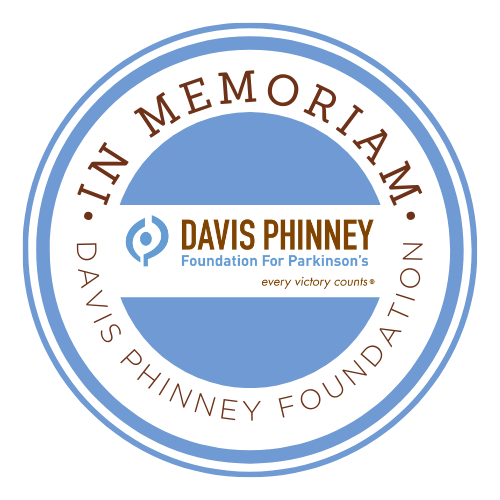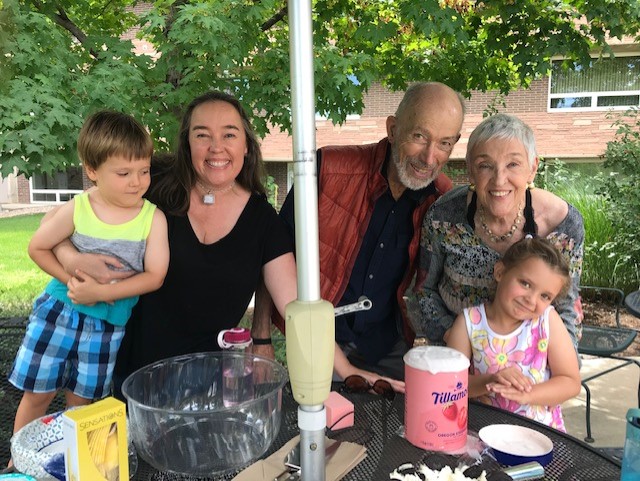Written by H. Paul Zeiger, PhD
I was diagnosed with Parkinson’s 15 years ago. I have spent seven of those years teaching yoga-based exercises to others with Parkinson’s. Since a set of principles characterized the yoga I had been teaching before, I naturally thought about principles for dealing with Parkinson’s. Recently, two excellent Davis Phinney Foundation webinars, one with Dr. Goetz and one with Dr. Savica, inspired me to dig out some principles of Parkinson’s and write them down.
“The world makes sense, and so do people.”
– Peter Ossorio, PhD, Author of The Behavior of Persons
This is a fundamental principle of behavioral science. It provides a foundation on which to build explanations of human behavior. Parkinson’s principles constitute building blocks for constructing explanations of the behaviors of persons with Parkinson’s. A Parkinson’s principle helps you make sense out of a tough diagnostic challenge. It is often a memory aid; short, catchy, and easy to remember. It speaks to some fundamental aspect of what you are facing in ways that promote understanding. And it carries implications for behaviors that might be useful to you. These characteristics make it practical.
Anyone with a diagnosis of Parkinson’s is likely to find the following principles relevant. For example, the first one that might be useful as soon as you are diagnosed could be this:
(P1) You may have Parkinson’s, but you also have a life.
When you have Parkinson’s, you’ll be tempted to give up. Don’t. “Just because you’re less than you were, is no reason to be less than you are.” (Jeffrey) And one of the things we know about Parkinson’s is that it’s impossible to know in advance where it will hit you or how hard. So don’t count yourself out or think that you can’t get back some or all of a function that your Parkinson’s is affecting, whether physical or mental. The overall circumstances of your life present very different challenges at age 70 than they do at age 40, so the age at which you were diagnosed matters. (Both Goetz and Savica made this point.) The principles that follow add strength to this one.
(P2) Life is made up of the actions you choose to take.
That includes not acting – Parkinson’s can render some of your valued habits more difficult. It is important not to let Parkinson’s push you into under-acting but instead push you toward regaining lost abilities.
When I was first diagnosed with Parkinson’s, my yoga practice included a handstand at the wall. Parkinson’s is particularly hard on actions that call for strength and speed simultaneously, so I lost not the handstand itself but the ability to kick up into it. Working with a revised arrangement of props and help from assistants, I regained it. If I had quit doing the handstand, I’d have lost it entirely. Eventually, I lost it again, but the proof that even a 69-year-old could regain something as challenging as a handstand was valuable to both my students and me.
(P3) As actions are repeated, they build habits.
This principle is compelling because it applies in both its negative and positive implications. In Goetz’s webinar, he says that if you continue to accept a hallucination, it will get more and more solid. To get rid of it, you have to practice seeing that part of the visual field as something that’s not a hallucination. The key is to practice conscious participation in the act of seeing. (See P6 for more detail.) My personal experience strongly supports Dr.Goetz’s advice.
The essence of P2 and P3 can be abbreviated into my favorite Parkinson’s principles:
(P4) For those with Parkinson’s, everything is therapy.
(P5) Parkinson’s is not the kind of threat you respond to by going below decks and battening down the hatches.
Years ago, when someone was diagnosed with Parkinson’s, he would retire to his bed and do nothing. Rest was the prescription of the day. In light of the principles proposed here, that amounts to throwing away your life. You are better advised to come out and confront Parkinson’s face-to-face. That way, you keep as much of yourself as you can – often in surprising ways.
(P6) Hallucinations (in particular) call for an aggressive response.
One evening, I was walking home at dusk along the path that runs along the creek in Boulder, Colorado. As I looked ahead of me, at many points, on either side of the path, I saw little groups of people standing around talking to each other. But as I approached each group, and my eyes picked up more detail, I realized the groups of people were actually the trees that lined the path. I hurried home and was relieved to figure out that I had missed a dose of medication that day, that the functioning of my visual cortex suffered as a result, and that the effects were temporary; they went away when subsequent doses of dopaminergic medications provided my brain with the proper level of dopamine and kept it relatively stable. After that, I began to observe whenever any strange visual phenomena happened. These visual disturbances seemed more likely to appear when I was either a little overdosed or a little under-dosed with dopamine. Fatigue also made these disturbances more likely. I never saw a hallucination created from absolute scratch; they would always start from a given sketch or outline.
Additional circumstances that make hallucinations more or less likely can be found sprinkled throughout the Parkinson’s literature, including (Goetz) and (Savica). One remarkable feature of at least the simple illusions that I have observed is that they invariably converted a “less interesting” image into a “more interesting” one, one that required more thought or action by me. Perhaps, when confronting a scene that lacks significant detail, the visual cortex makes a guess, erring on the side of increased complication or importance. Such a visual strategy might have some survival value, and if you are approaching the scene, you can peel away any information that the cortex has guessed wrong.
We know the visual system’s performance can be made better or worse, not only by biochemical considerations but by behavioral ones, such as mood, fatigue, emotions, etc. That is another place where one can get a handle on the visual system’s performance and make a positive difference therapeutically.
As you practice undoing hallucinations, you are implicitly exercising P3 — learning new skills. In other words, you are teaching yourself to see more accurately. There are also ways of helping your visual system to stay on the positive track. Idle neurons are infamous for spurious activity. If you have unwanted visions at night, learn to sleep with the lights on! Once, when I was bothered by waking up physically disoriented, I countered by making sure my night light illuminated a reference for vertical, like a door frame. Dr. Goetz reminds us that peace and quiet are not always the answer; sometimes, you have to stir up the neurons to engage them in a helpful activity. Availability of a visual reference for the vertical has become something that I now keep an eye out for all the time, especially at night.
(P7) Everything the human body does requires information to move through the body. Parkinson’s slows and weakens this movement of information.
A feedback loop carries information about the effects of an action back to whatever initiated the action. Feedback loops provide precise control over a myriad of physiological values, e.g., blood pressure, body temperature, saliva and skin oil production, the position of the limbs, the positions of the eyes, etc. Depending on which path it damages, Parkinson’s can impair the function of any of these feedback loops.
So, if you’re trying to identify things that might affect Parkinson’s, brainstorm a list of potentially vulnerable physiological feedback loops, all the things you can think of that are usually automatic. An excellent way to do that is to brainstorm ideas in a group. Here are examples:
(a) Many persons with Parkinson’s have trouble getting their eyes to track together. Such tracking problems are pretty common outside the Parkinson’s community, too, so optometrists and other eye specialists have developed exercises to improve tracking. These exercises can help persons with Parkinson’s as they have done for me on many occasions.
(b) To stand upright or walk, it is necessary to have an accurate, usually unconscious, sense of where the vertical plane lies. Your body estimates the position of vertical using three sources of information: the vestibular system (inner ear), vision (eyes seeing things that are oriented vertically, and proprioceptive feedback (forces transmitted to various parts of the body from the floor you are on). Sometimes the central nervous system has trouble making sense of these three inputs, and Parkinson’s can aggravate that. When you have a mild case, it may feel to you like the floor is gently rocking like the deck of a boat at anchor. Physical therapy courses designed to improve balance can be helpful in such situations.
(P8) “Dopamine is more like sugar than it is like an opioid.” – Dr. Rodolfo Savica
When determining the dosing strategy for pain using an opioid, your goal is to get enough pain-blocking chemicals in the right place to get rid of the pain. When figuring a dosage pattern for Levodopa, you are trying to keep the concentration in the bloodstream between certain limits over a defined period. That is more like what the person with diabetes is trying to do with sugar concentration in the blood. You have to know the strength over time of any medication, and no two have the same pattern. Getting a dosage pattern that is well matched to your needs may require experimentation run by a team of the patient, care partner, and neurologist.
That is all for now, but it is by no means the end of possible Parkinson’s Principles. I hope you will be able to see other principles to express your present and future insights about Parkinson’s because that could contribute to the speed and effectiveness of much-needed broadly based education regarding Parkinson’s. I would like that!
 We are saddened to share that Paul Zeiger passed away on January 10, 2023.
We are saddened to share that Paul Zeiger passed away on January 10, 2023.
Though you are no longer with us, Paul, you will never be forgotten. Thank you for being a friend and for the legacy you left to the Parkinson’s community.
More Resources
Video: YOPD: Biology, Treatments, and Living Well Today with Dr. Rodolfo Savica
Video: Dementia and Young Onset Parkinson’s with Dr. Rodolfo Savica
Video: Parkinson’s Disease Psychosis with Dr. Chris Goetz
Video: Parkinson’s Medication Management with Dr. Aaron Haug
Article: A Primer on Hallucinations and Parkinson’s


